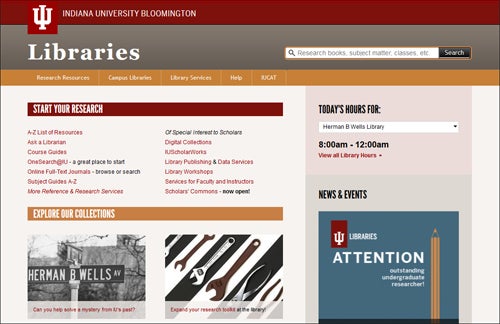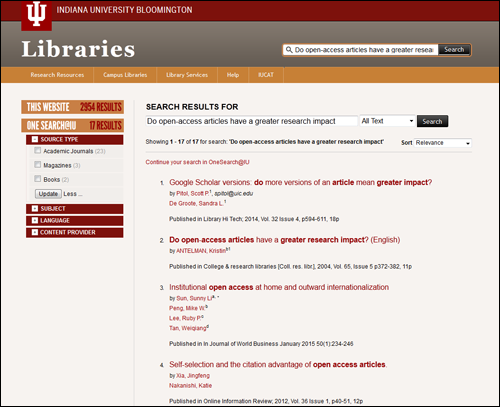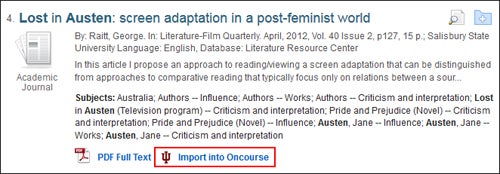
Overview
One of nine Indiana University campuses across the state, Indiana University (IU) Bloomington offers more than 180 majors and 330 undergraduate degree programs, as well as more than 190 master’s, doctoral, and professional degrees. The institution’s Herman B. Wells Library is the center of a multi-library system that serves roughly 40,000 students and 3,000 faculty members. Its collection includes more than 7.8 million books and bound journals, 800 databases, and 60,000 electronic journal titles. In addition, the library provides access to more than 500,000 eBooks.
In 2011, to surface more of its content, IU Bloomington implemented EBSCO Discovery Service (EDS) – known as OneSearch@IU – a robust library research tool that integrates many of the library’s resources in a single search. During the 2012-2013 academic year, the library saw the number of EDS sessions increase by 40 percent over 2011-2012. Since then, library leaders have worked to further enhance the user experience by migrating the library’s website from a locally developed content management system to Drupal, improving access to e-books, and integrating EDS with Oncourse, the university’s learning management system.
Over the last three years, throughout the course of these major enhancement projects, EDS has remained an integral part of the library’s information landscape.
“We believe EDS to be a superior product,” said Courtney McDonald, Head of Discovery and Research Services. “Our users consistently give us positive feedback on it.”
We believe EDS to be a superior product. Our users consistently give us positive feedback on it.
We believe EDS to be a superior product. Our users consistently give us positive feedback on it.
Library Website Migration & Redesign
Initially, IU Bloomington integrated the EDS API with its locally developed content management system. However, the library was limited in what it could do to improve the library website because the content management system was 12 years old.
“There was no future for a system that we wrote ourselves,” McDonald explained, “and there were viable open-source and commercial alternatives out there that do the things we wanted to do, and we really wanted to be part of a community again.”
In 2014, the library migrated its entire website – about 8,000 pages – to Drupal 7 and planned a major redesign that would focus users both on subscription resources and subject content. There remains a direct link to IU-CAT, Indiana University's online library catalog, which provides access to millions of items held by the IU Libraries statewide.
The new website offers a cleaner layout, and the single search box moved from the center of the home page to the upper right corner. To help users more easily differentiate among content types, the search results page gives them the choice to view website content or OneSearch@IU results.


“Librarians are resources and generators of content,” McDonald said. “If you think about faculty and students interacting with a subject specialist librarian, they’re having a conversation about a topic within that discipline; they’re talking about resources and research strategies. The website we had previously gave us the capacity to write a big list of stuff which, to me, was more like a lecture than a conversation. We really wanted to move toward a conversational paradigm on the website that mirrors more closely what a subject liaison does day to day.”
The EDS API search supports known-item searching and enables users to jump through to the native EBSCO interface or directly to the full text.
“We like being able to offer them something where they can do a search without having to make a choice ahead of time,” McDonald said. “People like putting stuff in a box and not having to decide a lot of things. We wanted to provide success, and by success I mean results, to the best degree possible and let people make those decisions later.”
While the default of the Drupal module developed for EDS is designed to be independent from EBSCO’s native interface, IU Bloomington wanted users to be able to easily leverage EBSCO’s valuable features and functions, such as personal folders, notes and permalinks.
“A good portion of our students and faculty have been using EBSCO resources in Indiana high schools and other Indiana colleges for a long time,” McDonald said. “It’s been a comfort for me to know that, if users conduct a search from the search box and they go through to OneSearch@IU, they are encountered with a thoughtfully designed, responsive interface. They’re getting handed through to an experience that’s comparable, if not better, than the one we have. I think EBSCO does a really good job in providing a good user experience in a very complex task situation.”
McDonald said the library plans to conduct user testing to validate their website design decisions and ensure that both novice and sophisticated researchers “end up in a place where their searches can be fruitful.” If the library needs to make design changes, she said, the EDS API is robust enough to support them.
Selection of EBSCO eBooks™ as a Preferred Vendor
Another benefit of EDS is that it provides users with quick and easy access to thousands of e-books. According to Lynda Clendenning, Head of Acquisitions, e-book titles are catalogued within a week of being ordered from YBP GOBI3, and the titles appear in OneSearch@IU results as soon as the MARC records are received and loaded. Since EBSCO eBook metadata is already indexed in EDS, any EBSCO eBook titles ordered from YBP appear promptly in EDS search results. This factor, along with EBSCO’s excellent user interface, led the library to set EBSCO near the top of its e-book vendor options in its YBP E-Approval Plan.
“We are seeing additional titles [appear] each week as part of this program,” Clendenning said, adding that the institution has purchased more than 10,000 EBSCO eBooks.
In addition, the availability of an e-book title displays in the detailed record, so OneSearch@IU users can see how many people are able to access the title at one time. Some titles offer unlimited use while others offer only single use.
“This information has been very helpful to users and to reference librarians,” Clendenning said. “Students know whether they can download the e-book right away or put it on hold. That’s been a huge benefit.”
Clendenning has also been working with EBSCO to capture turn-away reports for single use titles. These reports tell her how many times a user is unable to access a title because another user has already checked it out.
“When we find titles that get more use than we’ve initially purchased, we upgrade those titles to a higher user license,” Clendenning said, adding that users can access e-books anytime, anywhere, and from any computer or mobile device. “The e-book world is evolving quickly, and it’s challenging, but it’s also quite rewarding to make all this material available to our library users.”
[eBook availability] information [in EDS] has been very helpful to users and to reference librarians. Students know whether they can download the e-book right away or put it on hold. That’s been a huge benefit.
[eBook availability] information [in EDS] has been very helpful to users and to reference librarians. Students know whether they can download the e-book right away or put it on hold. That’s been a huge benefit.
Integration with Course Management System
The ability to integrate library content with course reading lists has been another key benefit of EDS. After discontinuing its e-reserves operation in 2013, the IU Bloomington Libraries still wanted to provide an easy way for faculty members to import citations and full text links into their course sites so students would have easy access to assigned readings. This was achieved by integrating EDS with Oncourse, the institution’s course management system powered by Sakai.
Now each search result in OneSearch@IU includes an “Import into Oncourse” button, so the process is easy. “Users can create reading lists and initiate a search from within Oncourse or from within EDS,” McDonald explained. “You can do it from either direction.”

Linking through to EDS saves the library staff from having to maintain a lot of additional uploaded files in the institution’s LMS. According to McDonald, the integration also allows her to better track a resource’s use because the number of full-text downloads are captured in EBSCOadmin’s usage reports, whereas a faculty-uploaded PDF was not countable beyond the first download.
In 2016, the University will migrate to Canvas, a learning management system with a more diverse tool set, including graphic analytics reporting, an integrated multimedia recorder, and mobile apps for iOS and Android devices. In addition, the library is currently investigating whether to implement Curriculum Builder, an LMS plug-in hosted by EBSCO that enables users to search a library’s content from within its LMS and create and annotate reading lists.
“I’ve been very impressed with what I’ve seen of Curriculum Builder and think it would be a fantastic asset for our students and faculty,” McDonald said.
Four of the Indiana University System’s nine campuses have selected EDS as their library’s discovery layer, and McDonald said she’d be happy to see all Indiana University campuses subscribe to EDS. She points to EBSCO’s excellent customer service as a major incentive.
“We have an excellent ongoing relationship with EBSCO staff,” McDonald said. “They are smart, committed people who have been great partners.”
Click the links below to learn more about the products mentioned in this story or to request a free trial.